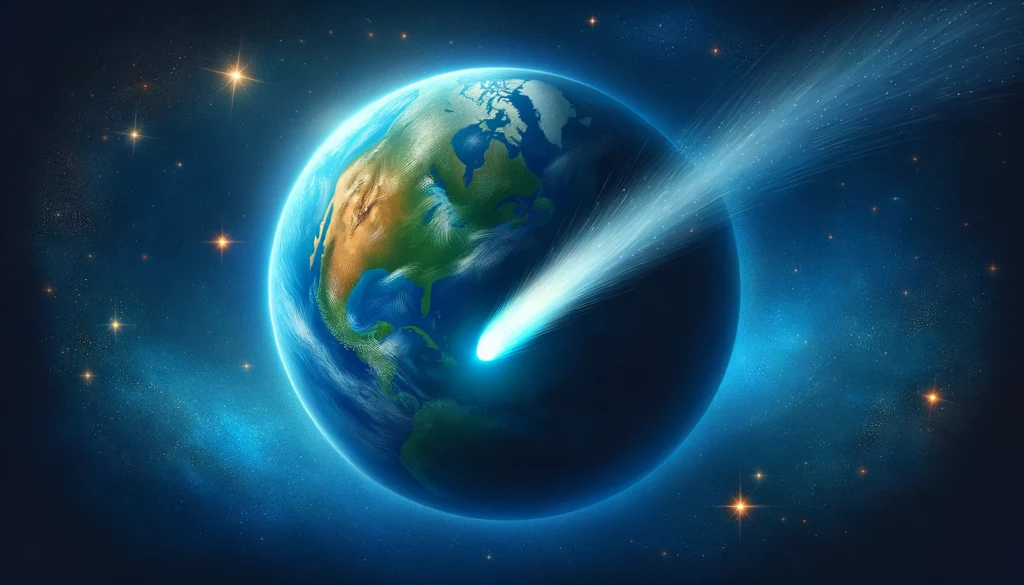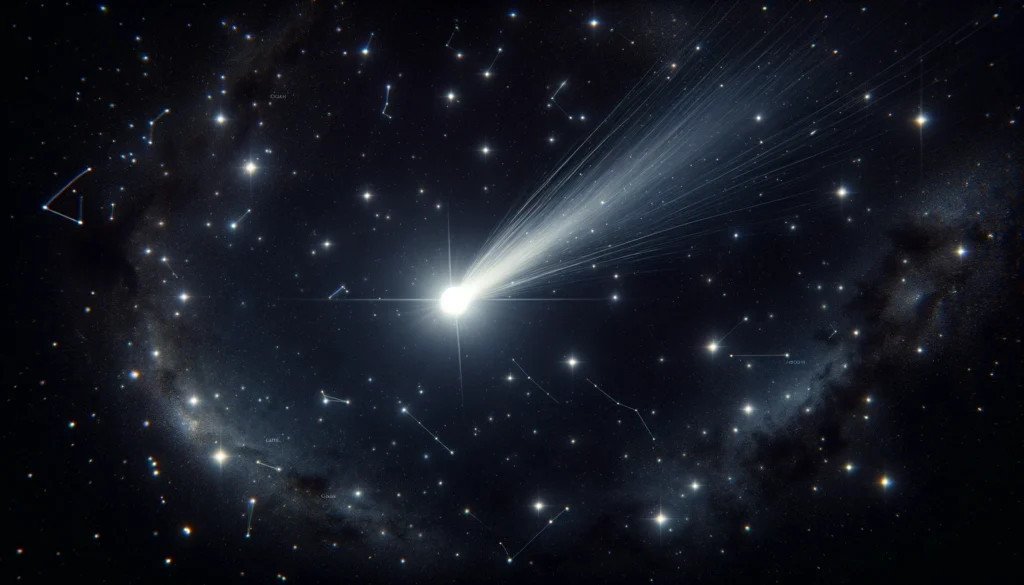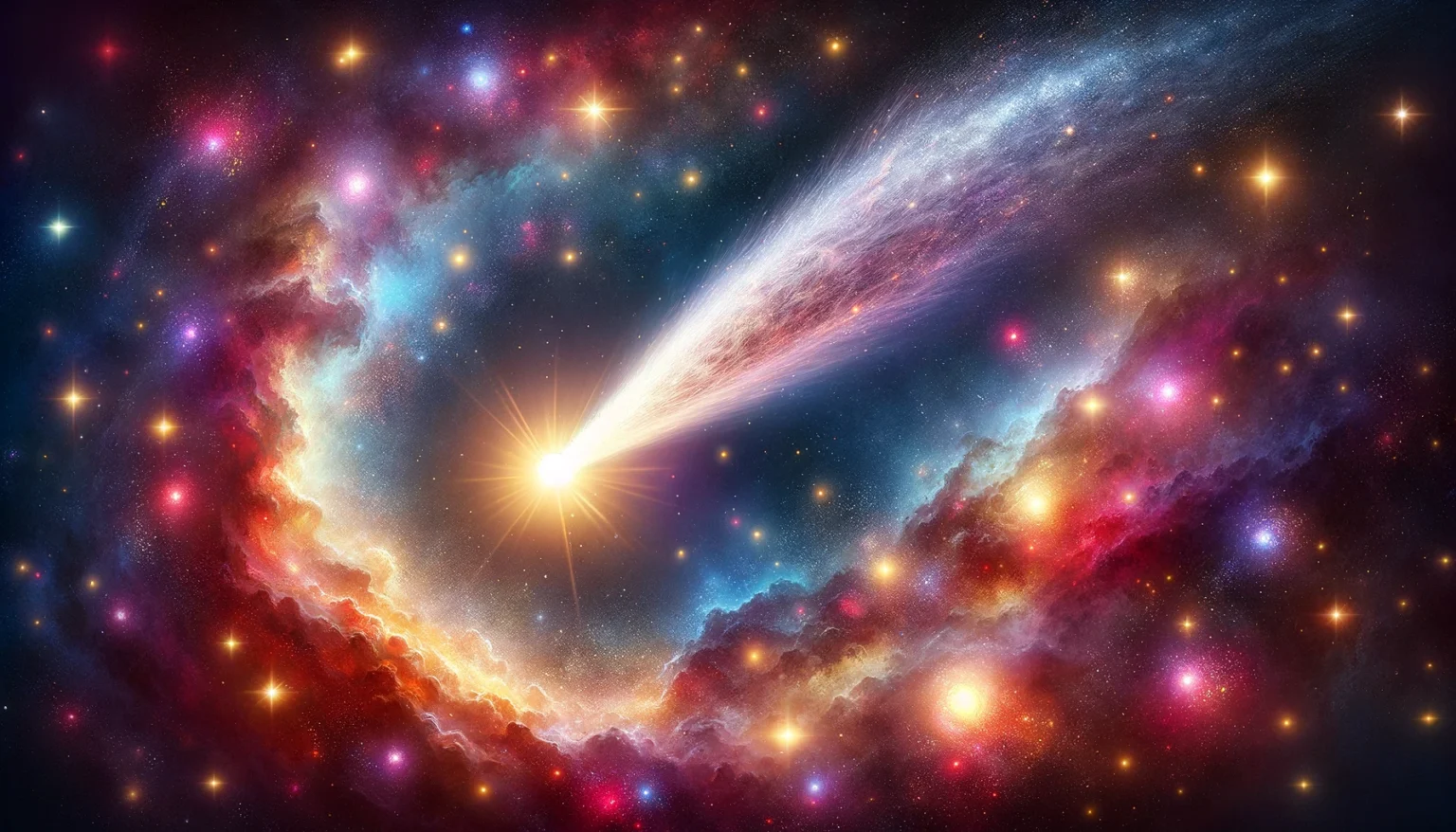Halley’s Comet Among those celestial wonders that never fail to ignite our imagination in the vast canvas of the night sky, Halley’s Comet occupies a position of great importance. Now through centuries, observers have been able to watch this most intriguing comet in all its glory. That awesome journey, a haunting appearance, and the potential to be something significant in the eyes of many people; Halley’s Comet testifies to the mystery of the cosmos.

Origins and Discovery of Halley’s Comet
Halley’s Comet, named after the English astronomer Edmond Halley, who computed its orbit in 1705, has been an enigmatic presence in human history for millennia. Its roots lead back to the outer space of the solar system and the icy debris that makes up the Oort Cloud. Every now and then, a passing star or some other disruption causes the Oort Cloud to have gravitational effects and sends comets racing toward the inner solar system.
How big is Halley’s Comet?
Halley’s Comet is one of the smaller objects of the solar system, although still gigantic in itself. The nucleus of the comet is the solid central part of it, measuring an approximate 15 kilometers at its longest dimension and around 8 kilometers in diameter. The composition of the nucleus includes a mix of water ice, dust, rocky material, and frozen gases.
However, the spectacular part of Halley’s Comet is the development of the coma and the tail that goes with the approach towards the Sun. The coma, although much less dense, can be larger than most of the planets. The Sun’s solar wind and the radiation pressure on ionized gas and dust particle make a tail extending into space by as much as millions of kilometers.
The nucleus of Halley’s Comet is thus relatively small, but it dramatically extends into a coma and tail when this comet comes near the Sun in the inner solar system, which it does periodically.
Last appearance of Halley’s Comet
The last time Halley’s Comet was visible was during its last apparition in 1986. The impressive phenomenon allowed the observer and the scientific community to have a magnificent view of the comet as it traveled through the sky. Since then, the comet has been towed back into the outer regions of our solar system on its long orbit. Today, Halley’s Comet is at the cold depths beyond Neptune, still making its way in the cosmos.
The 76-Year Voyage and the Law of Gravity
Why does Halley’s Comet appear only about every 76 years? It involves some intricate details of gravity and orbits. The long elliptical orbit of Halley takes it way out of the Solar System, where it spends most of the time. But gradually Halley comes back in toward the Sun, and the solar heat is strong enough to vaporize the frozen gases and dust in the comet, that becomes visible as its bright shining coma, or head, and tail.
Edmond Halley was a visionary who connected the dots between past apparitions of comets and concluded that they were, in fact, a single object with a periodic return. His very calculations presaged not only the return of Halley’s Comet but built the underpinnings of understanding the orbital dynamics of comets and other celestial bodies.
Also read – Was Mahabharata a Nuclear War?
Importance and Threats of Halley’s Comet
While Halley’s Comet is indeed such an amazing sight, it also raises questions on the matter of potential threats coming from space. While the comet itself may not pose a direct risk to Earth, it certainly serves to remind of the potential threats that populate our cosmic neighborhood. Some comets have their orbits taking them in close and dangerous vicinity to our planet, their impacts have certainly been noted in the past.
Comets like Halley’s are deeply important in the study of the origin of the early solar system. So much so that the comets are themselves sometimes tagged as “time capsules” because their material has remained relatively unchanged since the formation of the solar system. One is able to derive information about the conditions and building blocks leading to the making of the planets, including our own, from the analysis of the composition of the comet.
When will Halley’s Comet return?
Finally, Halley’s Comet is expected to return in 2061, and the expectations for such a re-encounter are very high. This longed-for occasion will be a rare opportunity for a new generation of astronomers and space enthusiasts to look at this cosmic marvel. Thanks to these new technologies, the 2061 apparition, especially through enhanced telescopes and space missions, may be critical in unraveling mysteries about the composition, structure, and behavior of the comet.
Averted Collisions: Why Hasn’t Halley’s Comet Struck Other Celestial Bodies?
Of all the enigmatic riddles within the life of Halley’s Comet, none is more arresting than its seemingly precise ability to avoid collision with any planet or moon. This can be explained by a pair of factors: the emptiness of space and the physics of celestial mechanics. Space, apparently crowded by the sheer number of objects present, in reality comprises vast distances between them.
All celestial bodies, be they a planet or a moon, have very definite orbits subject to the laws of gravity. These orbits have created “lanes” in space so that the chances of direct collisions are infinitesimally small. For Halley’s Comet, its orbit is so highly elliptic that it has to go on an orbit that avoids running into the path of the planets. These are the interlocking and disentangling dance of gravitational forces that orchestrate this avoidance for the solitary journey of the comet.
Looking Ahead: Exploration and Understanding
Beyond the aesthetic beauty, Halley’s Comet holds some value toward the future. Mysteries it may unfold and lessons it will teach us toward the history of our Solar System will be a continuous scientific interest. What is more, space probes, being sent to comets for their in-depth study, will bring irreplaceable information that can prompt a reconsideration of the understanding about these celestial wanderers.
Can ISRO’s forthcoming space missions reach space and view Halley’s Comet?
Future Indian space missions by ISRO are expected to be able to observe Halley’s Comet from space, depending on the mission in place and its objectives. The period of Halley’s Comet is about 75–76 years in its orbit, and it last appeared within the inner solar system in 1986. Its next appearance will be in 2061. If ISRO were to schedule a mission around that time, a spacecraft could indeed be equipped to observe and study the comet.
This would demand that such a mission be equipped with high-resolution comet observation instrumentation, among which are cameras and spectrometers. Additionally, the spacecraft would have to be repositioned in such a manner that a full unobstructed view of Halley’s Comet can be made as it transits the inner solar system.
With all these advances of ISRO and its ambitions in space sciences, and its recently achieved successful missions—Chandrayaan and Mangalyaan—it is not out of imagination that ISRO is going to plan a mission that includes an observation of Halley’s Comet. This will yield scientific data regarding the composition, structure, and behavior of the comet approaching the Sun.
Is Halley’s Comet going to crash into Earth in 2061?

No, Halley’s Comet will not crash into Earth in 2061. The comet follows a well-established and predictable orbit around the Sun. Its path has been calculated very well. The next time Halley’s Comet comes around—really next time, in 2061—it’s going to pass at a totally safe distance from Earth.
The closest approach of Halley’s Comet to Earth during its 2061 passage will be about 0.09 AU, approximately 13.5 million kilometers (8.4 million miles). This poses no threat of impact with Earth. While the comet is visible and will make quite an event for observers, its passage poses no danger.
Where is the comet currently located?

At present, Halley’s Comet lies in the constellation of Canis Minoris. The current distance of Halley’s Comet from the Earth is about 5.31 billion km; equivalently, that is about 35.5 astronomical units. It has a magnitude of about 25.62 and is thus very dim, if not invisible to the naked eye. Halley’s Comet, at such a distance, can be observed only through extremely powerful telescopes and long-exposure photography. Halley’s Comet now began its long return journey to the inner solar system and will be closest to the Sun at its perihelion on January 6, 2062






